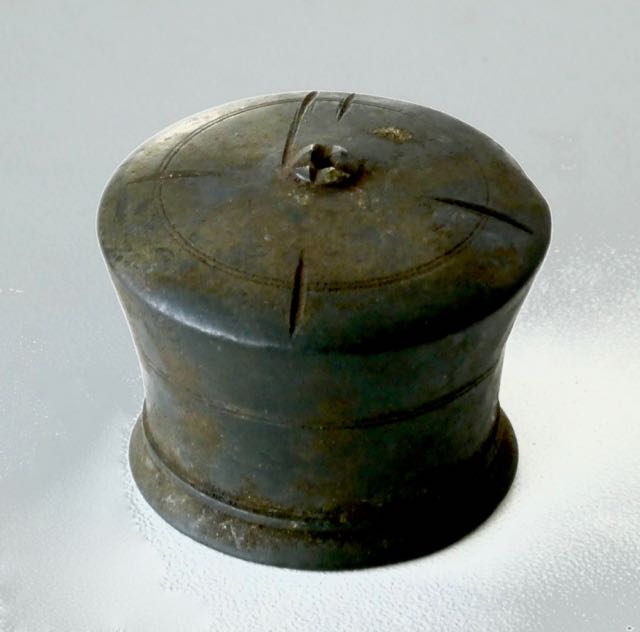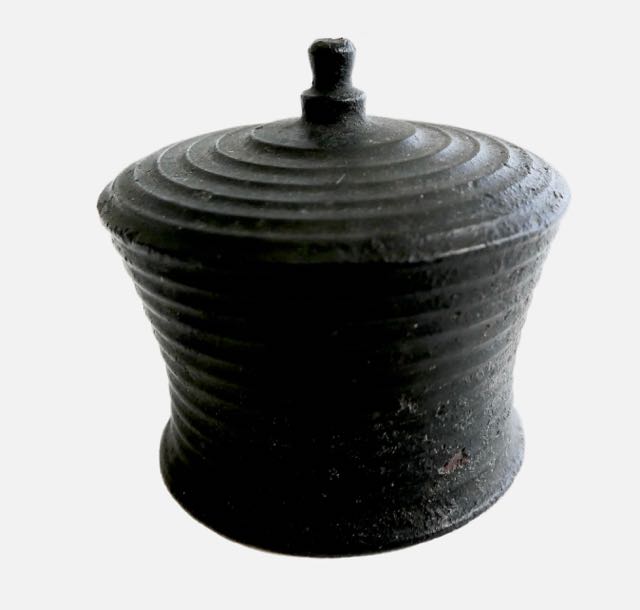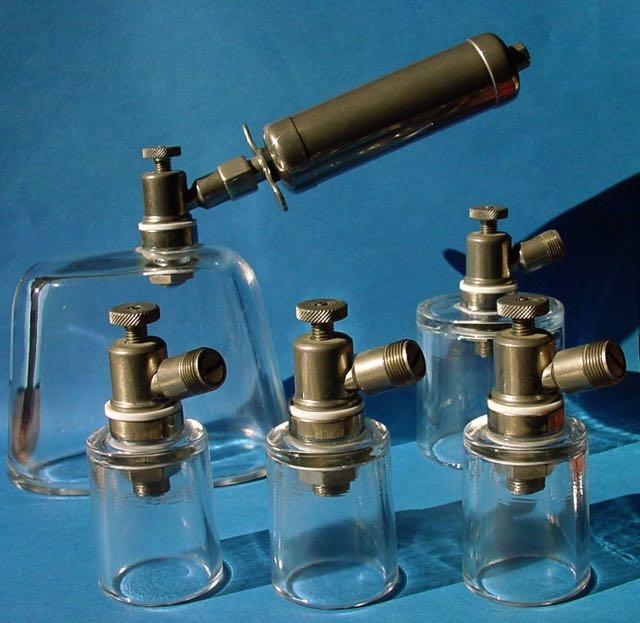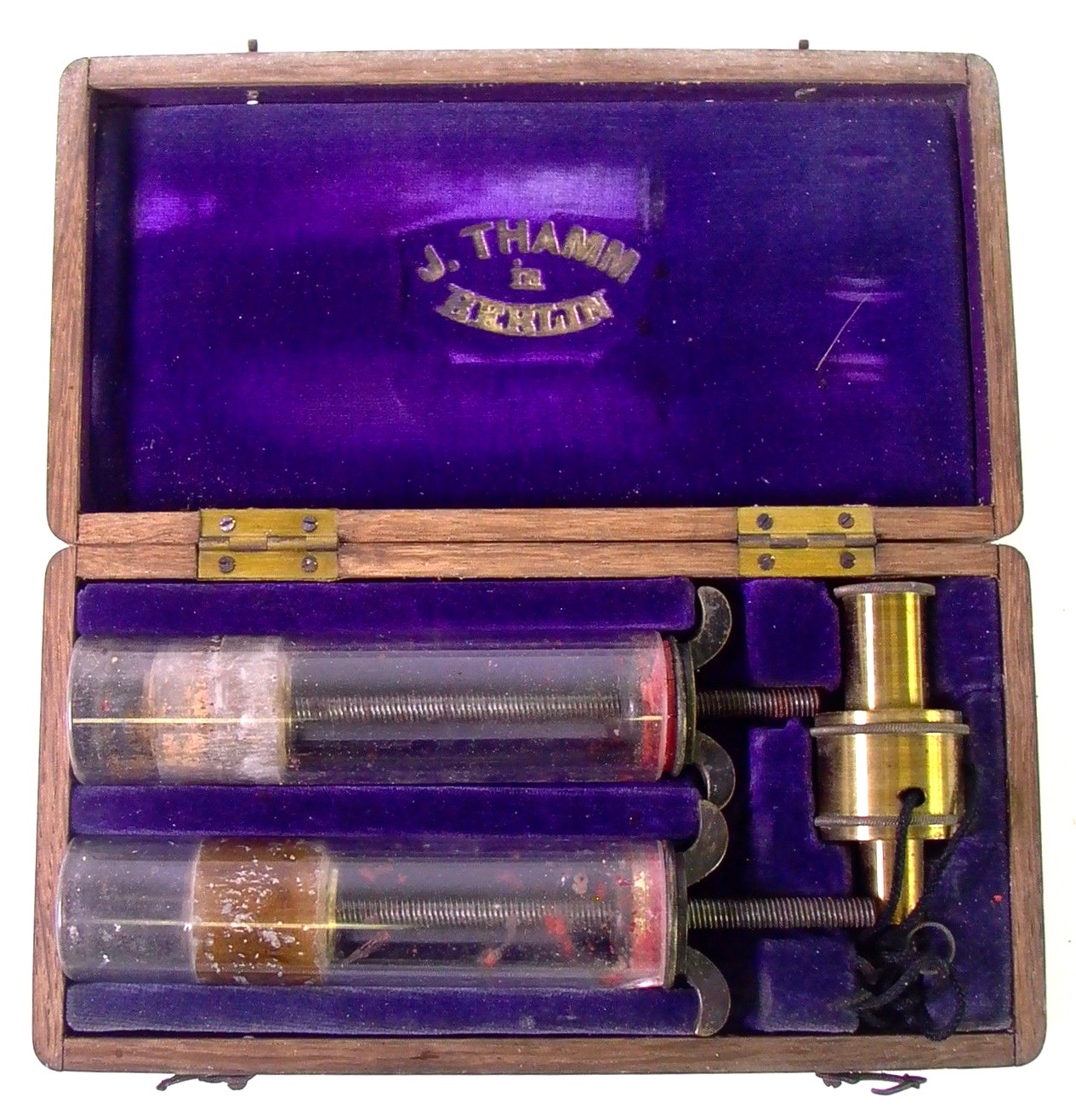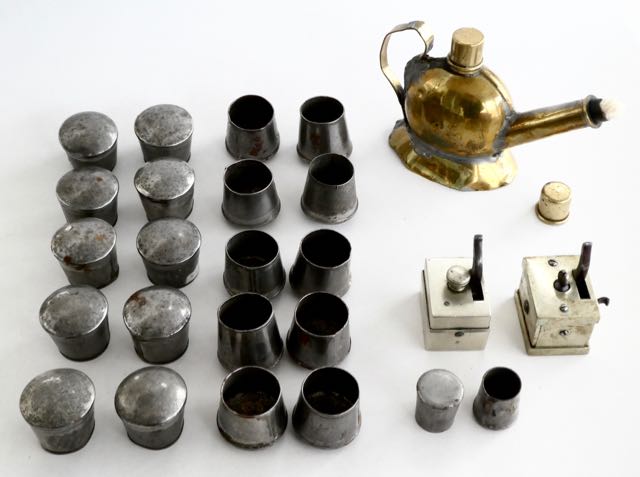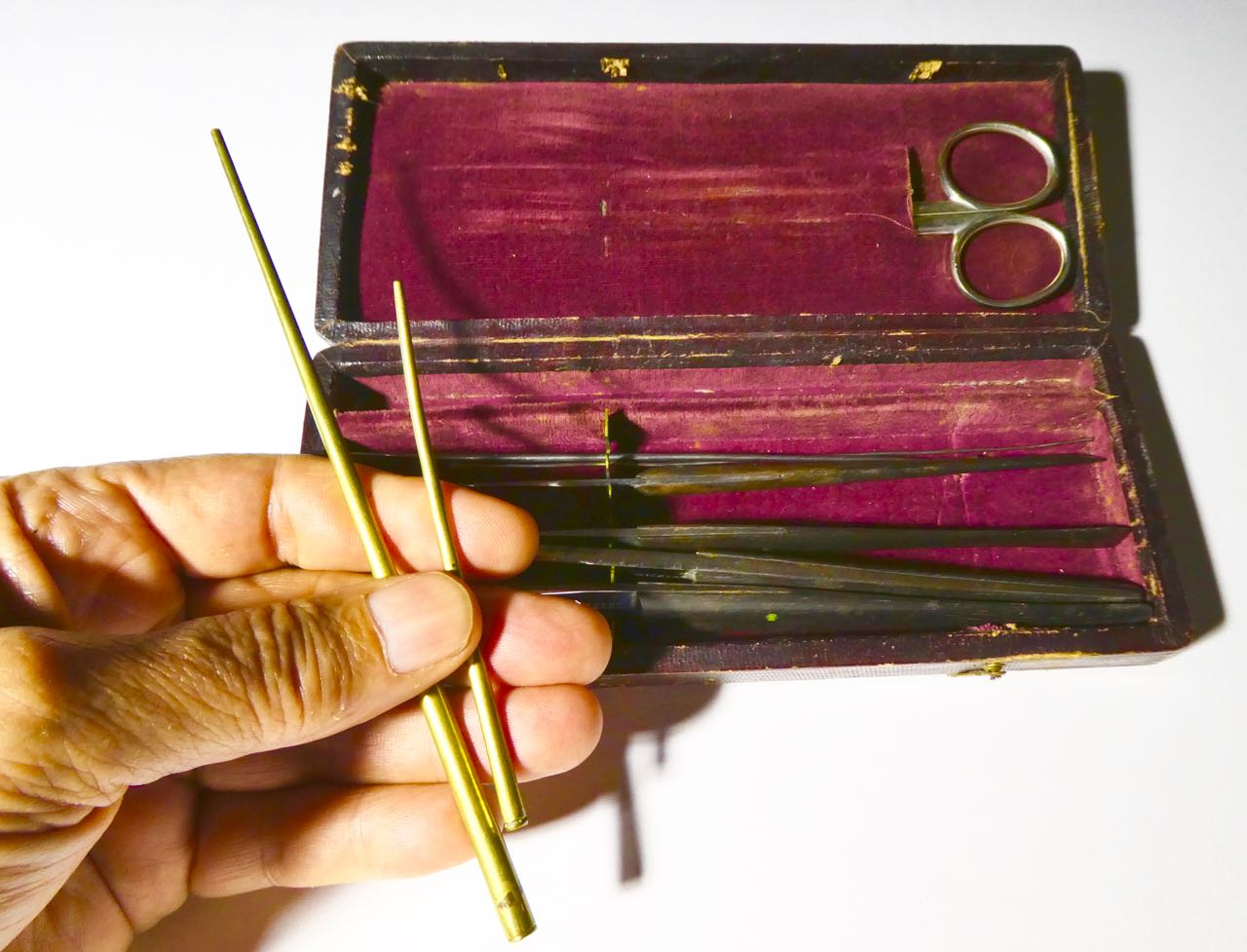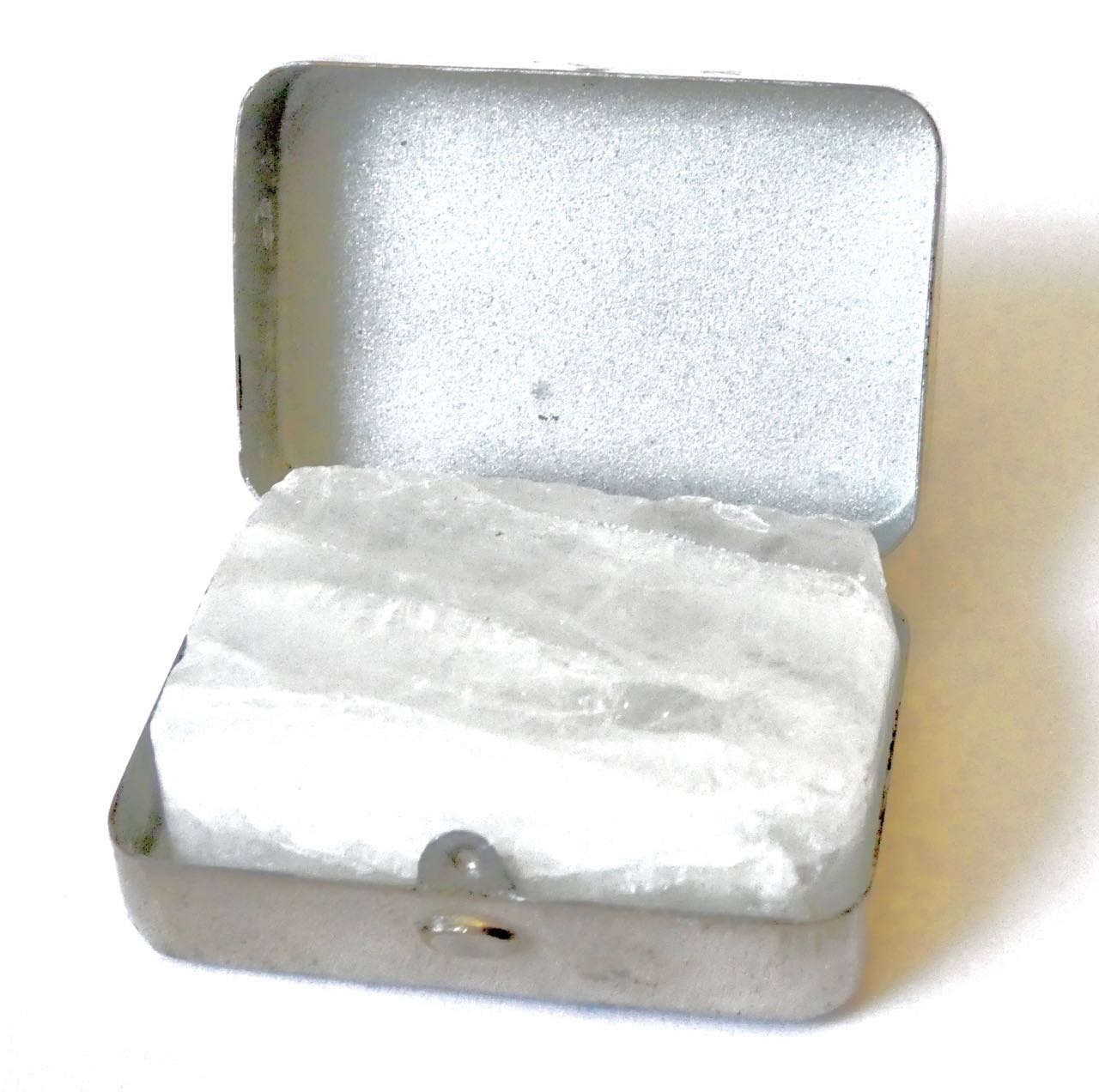Surgery |
||
Cupping glass (09) |
||
Since the procedure was safe, the payment of the individual act was correspondingly low - about one fifth of the Adrlasses. Nevertheless, cupping was starting, because of the frequency, an important source of income for the Bader!
We do not know in what form this cupping head was used, the dry or the wet variant. Even from the dry kind, there were several forms: "If you put the large or small cupping heads without cupping, they must, after they are fixed on the skin well, to derive the impure humidities as it were derived, something back and forth, which is why they are also called drawing heads" (Joh. Heinrich Zedler, Great complete universal Lexicon of all sciences and arts, Leipzig and Halle 1743 volume 35 p.1241). Nota: Under "pulling head" one understands today rather a head "pulls", not, as in the above text, a head "which is pulled" ...
Where to put the cupping head? "They are chiefly used in the stroke, in the paralysis, and in other such accidents, and in various manners, as at the stroke they are placed on the shoulder or on the spine; when the women are struck with stews, they are set on the surface of the thighs, and in the paralysis, on the part, which are struck with such a coincidence "(Joh. Heinrich Zedler, Great Complete Universal Lexicon of All Sciences and Arts, Leipzig and Hall 1743, Volume 35 p.1238).
Geek Indications In an East-Swabian manuscript of 1518 we read: "From the head of the Köpff. That makes it possible to do something with the head on the body that is good (..) for the stinging and permutter" (fol 96r-v) (Karin Schneider, The German manuscripts of the Bavarian State Library Munich, 1984) - side punctures and unspecified disorders of the uterus as main indications for the preparation of cupping heads. "If you want to breastfeed a woman every month, you put a very big head on her breasts" (Johannes Timmius, Hippocratis Aphorismi, Bremen 1744 p.336) - the master had once again watched great and without knowing that this suction He had given a cheap but valuable advice, provoking an oxytocin release that leads to a contraction of the uterus. "When the other is done, place a head on the blinded place, with which the poison is drawn out. Theriack / crushed garlic / sometimes Mithridat and Orvietan / will be placed on the injured part / so that the sting will be slightly damaged" (Germanus Adlerhold, cumbersome description of the anjetzo from the war newly endangered otherwise warm kingdom Neapolis, Nuremberg 1702 p.250).
Exhibit In the Middle Ages, the cupping heads were made of metal, mostly brass. Presented is a cupping pot (17th century?) Made of brass (diameter at the base 3.2 cm, largest diameter 3.7 cm, height 2.8 cm) from southern Germany. In case of need, it would have done a bulbous glass, but a glass did not like the hiking surgeon with it, because it went too fast on the way to break. Even the bath surgeon working in his bathroom pulled out a metal container: after a while, when the cups cupped bloody, the skin loosened and he fell to the ground. Scratches on the outside probably represent a human being: 2 legs abutting, 2 arms outstretched and one neck (headless). Curiously, one finds the same scratches, a bit more krackeliger in the execution, on the cupping of the "Healer of Tarrenz", where one of the cupping heads an animal with a wide mouth (cow?) As an indication that the Schröpfung was also used in veterinary medicine ,
Origin: Weissenburg (between Nuremberg and Augsburg).
Lit .: Birgit Tuchen, Public Bath Houses in Germany and Switzerland in the Middle Ages and the Early Modern Period (Petersberg 2003). |
Surgery |
||
Cupping glass (10) |
||
Comparing this cupping bowl with the previous one (9), the fluted surface is noticeable. Perhaps the relief was supposed to prevent the cupping head in the vapour bathhouse from slipping too far out of the Bader's hands and falling to the floor.
Repurpose In the 17th century cupping was placed in the hands of the Bader (French baigneurs) and Feldscher (military doctors). These only used the method of "bloody" cupping and did not sufficiently differentiate according to the corresponding clinical pictures. As a result, this method was slowly discredited by misuse and overuse. As a result, cupping heads could now be used for other purposes.
The Nuremberg manufacturer of coin scales, master Paulus Deinert, used from 1758 as a hallmark the letters PD together with the Loßkopf (Lass head) resp. Cupping cup - cupping head as a family nickname.
Later, the heads were literally "abused" - I have already spoken of their use as a reliquary container: "On the Fildern (pointed cabbage fields), the cupping heads were inherited from generation to generation - and rich farmers' daughters like to give in the dowry In the small metal cylinder fit exactly exactly 1000 pieces of the small balls - what the farmer when sowing the because of its high price also like to be called "Filder caviar" seed more than just a rough overview on the oversized thimble to measure the Filderkraut seeds So it came to the unit of measurement "Ventaus" ... The still well-known size with a bottom diameter of 3.7 centimeters goes back to the year 1806 and holds a Württemberg cubic inch, ie 22.12 cubic centimeters (Sascha Schmierer, The measuring cup for the precious "Filder-Kaviar", Stuttgarter Nachrichten, What's on the 20th October he 2015).
The Stuttgart were not the only ones who used cupping to measure: "Good to make bratwurst (..) also at will / a handful of half-boiled pepper and marjoram / at will / a Laß-Kopff full Coriander / and hack it all klein "(Fridericus Frisius, The Most Distinguished Artist and Handwercker Ceremonial-Politica, Leipzig 1708 p.831).
Exhibit "Baderskopf", bronze. Dimensions: max. Diameter 3,6 cm, opening 3,3 cm, height over all 3,3 cm. Bevelled outside. Origin: Southern Germany
see. Cupping head, locality: Burg Prandegg. Upper Austria. Castle Museum, Reichenstein. |
Surgery |
||
Cupping glass (11) |
||
Occasionally, I had doubts as to whether the device shown here is really something medical or a pornographic article that causes the vulva to swell. I was not reassured until I saw a very similar device, which was made in the 1930s by Franz Itting in Probstzella / Thuringia, in whose glass bells was written read "cupping hyperaemator".
Lit .: The cupping hyperaemator, a new high-quality therapeutic for the general practitioner. A contribution to the history of the cupping process. Fa. Franz ITTING (ed.), C. 1935.
Franz Itting (1875-1967) had founded a power station in Probstzella in 1909, bringing the power supply to southeastern Thuringia. Socially very involved, he was put into a concentration camp by the Nazis as "Red Itting" and again imprisoned and expropriated by the communists after the war in 1948. In 1950, after being released from prison, he fled with his family to Ludwigsstadt in neighboring Bavaria (Kronach district) and built there - at the age of 75, again an electricity company, which still exists today. For the cupping heads, the company supplied the matching Skarifikator: "To cut the cuts, it is best to use a small device that ensures almost painless cutting, depending on whether you have a heavy, obese patient in front of you or an asthenic, take the larger or smaller knife insert to always clean this apparatus well, what happens with the aid of a device supplied by the named company (Mrs. Itting) "(Aschner-Fibel, 13th edition Haug-Verlag Heidelberg 1996 p.98).
Homer describes in the IVth canto of the Iliad how in the ancient Greeks after the removal of an arrow the wound (by Menelaus) was sucked out. GALEN designed his own instrument, the "pyulcon".
In the first half of the 18th century, the French surgeon Dominique ANEL (1679-1740) invented a small suction syringe to replace this so-called "soldier's sucker". Until then, groups of men and women on the battlefields of "honor" had been busy vacuuming the soldiers' wounds to remove dirt as a source of infection.
Lit .:
|
Surgery |
||
Cupping glass (12) by HEURTELOUP |
||
Artificial leech by Heurteloup, "which consists of two independent instruments, namely a punch, which is rotated by the rapid unwinding of a wound around the stem of the same string at high speed and thereby produces a ring-shaped, severely bleeding skin wound, and from a A glass cylinder in which a good-closing stamp can be moved up and down by means of an iron rod If the skin has been wounded with a puncher, the glass cylinder is set up and made relatively deflated by pulling up the stamper, whereby the blood from the entire wound surface Often the artificial leech is used by ophthalmologists because of its convenient handling and the more accurate assessment of the amount of blood to be withdrawn "(Meyers Konversations-Lexikon, 1888).
Origin: Bavaria, Berchtesgadener Land / Germany.
Manufacturer: Fa. Hermann Katsch / Munich, founded in 1865.
Distribution: Instrument factory of J. Thamm / Charitéstr. 4, Berlin resp. Karlstr.14 |
Surgery |
||
Cupping lamp |
||
If you do not want to suck the cupping glasses with a pump or with your mouth, you are - despite all the fear of burns - reliant on heating the air in the bell over an open flame.
Exhibit Multiple soldered jug. In addition 20 large and 2 small metal cups as well as 2 square Schnepper. Origin of the set: Saint Agnan / Bourgogne.
3 similar lamps can be found in the following company catalogs: - Waldek & Wagner, 1905. Price book on surgical and medical instruments and aids, bandages, orthopedic machines and artificial limbs, dressings, appliances for the care and relief of the sick. (P.128, fig.2137); - Katsch, Hermann, 1906. Main Price List, p.151, fig.1945; - Wendschuch, Carl, 1910. Main Catalog, S.200, fig.131.
|
Surgery |
||
Dissection box (1) |
||
From 1875 on, the University of Tübingen made its dissection courses obligatory:
About the manufacturer "His Majesty the King, on the 27th of March, gave the instrument maker Joseph Wickert in Munich the gracious title of a university instrument maker", says the Governmental Gazette of the Kingdom of Bavaria 1827 p.256).
The undersigned hereby gives the honor to announce that he has left his former apartment in the Sonnenstrasse and moved into his new quarters in the Kanal-Bellstrasse, HV House-Nro 1284 Lit. B.
On this occasion he recommended himself to pleasing ones Orders in all types of surgical instruments, as well as in bandages and machines, also to other mechanical work.He also razor of the highest quality, as well as to order, all types of table and dessert knives are made, he flatters a complacent Zuspruchs, and assures prompt service and the cheapest prices Munich, May 10, 1829 Joseph Wickert, manufacturer of surgical instruments at the Ludwig Maximilian University of Munich "(Der Bayerische Landbote, 16.5.1829 S.497).
According to the information of the royal court doctor Dr. Wenzel, the royal instrument manufacturer Wickert dahier has manufactured and simplified the Civiale instrument for crumbling the bladder stones in a manner which is the most common use for this important operation Mr. Wickert, therefore, in agreement with the Royal Court and Surgeon Dr. Wenzel, has obtained a most gracious certificate from the Royal Government.The advantages of this instrument before the Civiale are: 1) very easy introduction, without preparation, and 2) quite safe handling in the urinary bladder, 3) the possibility of starting the operation at the same time, without removing the instrument, at the first examination for diseased bladder stones, 4) possibility of injections into the bladder without taking the instrument out, 5) by half simplified apparatus at 6) comparatively low cost of 4 to 5 louis d'or the Civiale instrument in Paris costs between 1000 and 1200 francs, in Germany between 25 and 30 louis d'or "(Beylage to the Allgemeine deutsche Zeitung für Russland, 5.1.1829).
Apparently, WICKERT also developed an osteotome that was later modified: "Carl Nood, Alterations to the Osteotome by Mr. Wickert, University Instrument Maker in Munich, Munich 1836".
In 1840 he exhibited in Nuremberg and was showered with praise "WINKLER in Munich and HAMMON in Nuremberg are distinguished by the quality of the material and the meticulousness of the work, especially with regard to sanding and polishing." As late as 1845, Wickert was a member of the Polytechnic Association of Bavaria (Kunst- und Gewerbeblatt of the Polytechnic Association for the Kingdom of Bavaria, Munich 1845). When the business went well, he expanded: "Wickert Joseph, a university instrument maker, also has a large publishing house in the Kaufingerstr.3" (Universal Manual of Munich 1845 p.308).
Similar cutlery "Complete anatomical cutlery requires 1 cartilage knife, 4-6 single- and double-edged secirmite of various sizes, one or a pair of scissors, a pincette, a bone saw, a tubule, a hook, multiple probes, staples, etc." (Johann Friedrich Pierer, Anatomical-physiological real dictionary, Leipzig 1816 p. 239).
In the catalog of the Medicinische Waarenhaus A.-G. Berlin, printed around 1910, we find on page 314 an "Anatomical cutlery, model Kaiser Wilhelm Academy, containing: 1 incision scissors, 1 cartilage knife with scraper, 1 nerve meter, 2 large scalpels, 2 medium scalpels, 2 tweezers, 1 double tubulus, 3 probes, 1 climbing hook, 3 needles, 2 chisels ". We are particularly interested in the "double tubule", which also appears in our WICKERT cutlery. What was he for? In the book "The Conservator" by August Vollrath Streubel (Berlin 1845) we find in the paragraph on anatomical cutlery the statement: "a tubule with a tap to inflate caves and canals".
In the (actual!) Catalog of the company Fred Mattes we do not only find "tubuli" on offer, but also the suitable English translation: "blow pipes" ...
Exponat Besteckkasten von Joseph Wickert, erworben als "Chirurgisches Besteck" auf dem Flohmarkt von Völs 4/2017.
|
| Surgery |
||
Dissection, box (2) |
||
For the undergraduate, the biting Formol smells in the Prisoner's Hall are a first hurdle - as the eyes tear and the stomach revolts. But concrete anatomical experiences belong to the basic knowledge of surgery, and, as the great anatomist Friedrich TIEDEMANN (1781-1861) said:
Exhibit The box presented here comes from my student days in Freiburg - a reminder of the Anatomy Courses under Prof. Eugen FISCHER (1874-1967) and Prof. Ludwig KELLER (1910-1977). Both prohibited the use of chain hooks, which at many universities, the tissues are kept apart on the corpse. They rightly considered the risk of injury to be too great and did not want to see the chain hooks in their room: the fear of the "corpse poison" was reversed. In fact, many a student has sustained a dangerous finger / hand injury, in the worst case a deadly injury while preparing corpses.
The body parts of killed or deceased animals may contain corpse poison, protein decomposition products such as cadaverine and putrescine. The decomposition of animal protein usually involves the bacterium Clostridium botulinum. These bacteria multiply particularly well on meat and fish and produce the poison "botulinum toxin", which orally (ie when eating) in the tiniest amounts is deadly - namely at 0.001 mg. Botulinum Toxin is a Synapsengift, which prevents the release of messenger substances (acetylcholine) on the musculature. Death occurs through respiratory paralysis, i. The diaphragm is no longer controllable by our brain. Incidentally, the corpse poison is considered as a possibility in the production of biological weapons e.g. Poison drinking water.
Leichengift (also Ptomain, corpse base or Leichenalkaloid called) is a (mostly misleading) name for the resulting in protein decomposition by bacterial decomposition of lysine and ornithine biogenic amines cadaverine and putrescine, which are a reason for the smell of corpse corpses. In addition, sulfur compounds such as hydrogen sulfide play a role, which are toxic in itself, but not present in high concentration. Although corpses have also been used to poison wells and bodies of water in warlike conflicts, the substance "corpse poison" does not exist. Depending on the cause of death and degree of corrosiveness of the body, a particular pathogen (eg, pest bacilli) or a bacterial toxin is responsible for the ill effects. In dealing with corpses z. B. in funeral companies, that a harmful effect due to skin contact or inhalation of "corpse poison" is excluded. In case of oral ingestion or transmission by injection or incision injuries (trauma), however, diseases are possible: - by bacterial toxins (eg botulinum toxin, tetanus toxin), - by fission products due to protein rot. Accidents in dissecting rooms are therefore never due to corpse poison. At most, they are caused by particularly virulent bacteria, despite surviving formaldrough the body survived resp. the body settled after the death of the person ...
Nota: the hooks in the foreground of the picture are from the estate of the doctor, Roger SEILER (1911-1975), who had settled in the capital since 1945. |
Surgery |
||
Drainage tube |
||
„Pus bonum et laudabile "was once said. But at some point it was said, this pus should be removed from the body ...
|
Surgery |
||
Etching alum stone |
||
Countless wet razors have used Alum-stone for centuries to treat their every-day blemishes. Alum has the desired, strongly astringent effect! Applied to small bleeding wounds, it pulls the tissue together and the platelets can close the wound faster. While it was common in the past to keep a compact block of alum on wounds, today one takes rather a Alaunstift. It is most commonly used after wet shaving and trimming and claw care of pets. The pen can also be used as a deodorant, as alum hinders bacterial growth. A disadvantage is the burning of the skin, which is caused by the action of the alum.
|
Chirurgie |
||
Etching lunar caustic (1) |
||
From 1800 on, doctors seldom burned, but etched all the more. Popular was the so-called hellstone, which, as the name suggests, burned away everything "devilish". When one was still searching for the philosopher's stone (lapis philosophorum), it was common to call "stones" in this way:
Use
|
Surgery |
||
Etching lunar caustic (2) |
||
Silver nitrate (Argentum nitricum) is a strong oxidizer. It can attack organic tissue, reducing silver ions to elemental silver and oxidizing the organic material. Silver nitrate + potassium nitrate rods are used as "hellstone", for example to remove proliferating tissue or warts. Silver nitrate + potassium nitrate rods are used as "hellstone", for example to remove proliferating tissue or warts.
|
Surgery |
||
Etching lunar caustic (3) |
||
Kupfer kommt in unsern Apotheken in 3 Verbindungen vor: - als (schwarzes), wasserunlösliches Kupfer-II-oxyd (CuO) (Pulver oder Pillen) - als Kupfersulfat (CuSO4) (blauer oder Kupfer-Vitriol) ("crudum" als Ätzsift, "rein" als Brechmittel, "ophthalmicus" als Augen- resp. Wundstein, als "Vitriolsalmiak"). - als Grünspan (Kupfer(II)-acetat), als "emplastrum".
Kupfersulfat gehörte zu den Lieblingsmitteln des Paracelsus. Metallsulfate, die Vitriole, waren in der Paracelsuszeit normale Handelsartikel. Erhältlich waren grüner Vitriol (Eisensulfat), blauer Vitriol (Kupfersulfat), weißer Vitriol (Zinksulfat) und natürliche Mischungen aus dem Bergbau. Beim Brennen der Vitriole entstehen zunächst basische Sulfate, dann schwefelfreie Oxide. Paracelsus verwendete besonders den Crocus Veneris (Cu2O), der seit der Antike durch Kochen von Kupfersalzen mit Honig hergestellt wurde ("ägyptische Salbe").
Zu den Ätzstiften Einen Ätzstift herzustellen war ein kompliziertes Unterfangen: "Bereitung von Aetzstiften aus Kupfersulfat. Von W. Weber, Apotheker in Lich. Das Bereiten von Aetzstiften aus Kupfersulfat nach der Methode von W. Steffen in Homburg (Arch. d. Pharm. 11. Bds. 6. Heft) hat seine Schwierigkeiten; wenigstens gelang es mir mit kleineren Mengen Kupfersulfats nicht, eine solche Schmelzung zu bewerkstelligen, dass aus der Masse, gleich einer Plaster- oder Pillen-Masse, Stifte geformt werden konnten. Der Vitriol wird bei dem gelindesten Feuer nur feucht, bleibt aber stets bröcklich und zerfällt schliesslich zu einem weissen Pulver. Nur beim Erhitzen grösserer Quantitäten des Kupfersulfats gelingt es, eine einigermaassen geeignete Masse zu erzielen. Sicher gelingt die Herstellung schöner Stifte, wenn man das durch Erhitzen von feinem Krystallwasser befreite Kupfersulfat zur Bereitung benutzt. Hiernach bringt man den im Trockenschrank verwitterten Vitriol in eine kleine Porzellanschaale und erhitzt mittelst einer Wein- geistlampe unter Umrühren solange, bis auch das letzte Atom Wasser vertrieben ist. Ist dies der Fall, so hat das vorher leicht bewegliche feine Pulver in der erhitzten Schaale seine Leichtigkeit verloren und fällt nun beim Umrühren schwer zusammen. In diesem Zustande ist das Sulfat fast weiss und zur Bereitung der Stifte geeignet. Nun macht man sich aus gutem Filtrirpapier über einem runden Bleistift oder einer Glasröhre von solcher Dicke, als man die Stifte haben will, durch 3 bis 4 maliges überrollen Hülsen, deren untere Oeffnung man zudreht und deren obere Endecke man mit ein wenig Harz festheftet. Das Ende seiner ganzen Länge nach mit Gummi anzuheften, ist nicht zu rathen, weil hierdurch später das Eindringen des Wassers nur ungleich erfolgen kann, wodurch die Stifte krumm werden. In diese Hülsen füllt man nun das trockne Kupfersulfat ein und bewirkt durch wiederholtes Aufstossen der Hülse ein festes und gleichmässiges Setzen des Pulvers. Das Stopfen mit einem Glasstabe ist ebenfalls nicht anzurathen, weil dadurch dichte und weniger dichte Schichten entstehen, die nach der Erhärtung Brüche veranlassen. Die oberste Lage drückt man etwas fest und schliesst nun die Hülse auch oben durch Zusammendrehen des mit Kupfersulfat nicht gefüllten Theiles der Papierhülse mit den Fingern. Die so präparirte Hülse rollt man in ein entsprechend grosses Stückchen alte Leinwand ein, welche man vorher mit Wasser getränkt und mit der Hand wieder fest ausgedrückt hat, mit der Vorsicht, dass das in der Hülse festgestossene Pulver keinen Bruch erleidet. Das entwässerte Kupfersulfat saugt mit grosser Begierde das Wasser durch das Filtrirpapier ein, um dasselbe zu binden und mit demselben gleich gebranntem Gyps fest zu werden. Nachdem die gefüllten Hülsen in der feuchten Leinwand 3 bis 4 Stunden oder auch über Nacht ruhig gelegen haben, hat das entwässerte Kupfersulfat wieder sein sämmtliches Krystallwasser ersetzt. Die Stifte werden nun herausgenommen, sind vom Wasser vollständig durchdrungen und brauchen nur, im Falle sie durch Mehraufnahme von Wasser weich geworden sind, etwas getrocknet zu werden, um ihnen diejenige Härte zu geben, die man von Aetzstiften verlangen muss. Meistens wird dies schon beim Liegen in Zimmertemperatur rasch herbeigefiihrt. Nun lassen sich dieselben theilen und nach Belieben mit einem Messer zuspitzen" (Internet).
Exponat Vorgestellt wird ein apothekenfrischer Ätzstift mit einer Kupfervitriolspitze (Cuprum sulfuricum, vitriolum cupri). Das Pharmaziemuseum Peer in Brixen besitzt ein rundes Pulver-Schächtelchen (Inv. Nr. 04592) mit einer ähnlichen Kupfervitriol-Spitze aus dem 19. Jahrhundert "Aus Kupfersulfat und einigen Tropfen Wasser unter Einwirkung von Hitze geformter Ätzstift".
Geschenk von Herrn Mag. Dr. Andreas Winkler, dessen Vorfahren Apotheker in Innsbruck waren. |




